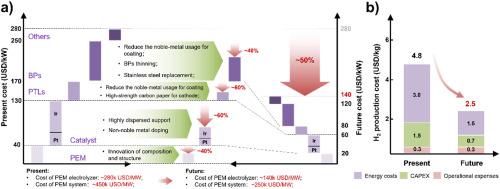推进质子交换膜电解:从可负担的制氢成本的角度
IF 17
1区 工程技术
Q1 ENERGY & FUELS
引用次数: 0
摘要
质子交换膜水电解在可再生集成制氢方面具有关键优势,包括快速动态响应(<1s)、高电流密度(>3 A cm - 2)和加压输出(≥350 bar),以降低压缩成本。然而,高昂的材料成本(ir基催化剂、Ti双极板、膜)和恶劣条件下(pH 2-4、60-90°C、O2饱和度)的耐久性挑战阻碍了商业化。最近的进展提出了多层次的优化:1)材料创新(低铱催化剂,耐腐蚀多孔传输层等);2)界面工程,增强三相边界,减轻催化剂隔离;3)组件集成(一体式电极组装,人工智能驱动优化配置)。技术经济预测表明,通过规模化生产和提高效率,成本将降低50 - 60%,到2030年可能达到2.5美元/公斤氢气。通过人工智能驱动的部件配置参数和系统控制策略优化,可以进一步加快氢燃料电池汽车廉价化的实现。本文章由计算机程序翻译,如有差异,请以英文原文为准。

Advancing the proton exchange membrane water electrolysis: Perspective on the affordable hydrogen production cost
Proton exchange membrane water electrolysis demonstrates critical advantages for renewable-integrated hydrogen production, including rapid dynamic response (<1s), high current density (>3 A cm−2), and pressurized output (≥350 bar) to reduce compression costs. However, high material costs (Ir-based catalysts, Ti bipolar plates, membranes) and durability challenges under harsh conditions (pH 2–4, 60–90 °C, O2 saturation) hinder commercialization. Recent advances propose multi-level optimizations: 1) Material innovations (low-iridium catalysts, corrosion-resistant porous transport layers, etc.); 2) Interface engineering to enhance triple-phase boundaries and mitigate catalyst isolation; 3) Component integration (one-piece electrode assembly, artificial intelligence-driven optimized configuration). Techno-economic projections indicate 50–60 % cost reduction through scaled production and efficiency gains, potentially achieving <2.5 USD/kg H2 by 2030. Through AI-driven configuration parameters of components and system control strategy optimization, the realization of inexpensive hydrogen for fuel cell vehicles can be further accelerated.
求助全文
通过发布文献求助,成功后即可免费获取论文全文。
去求助
来源期刊

Etransportation
Engineering-Automotive Engineering
CiteScore
19.80
自引率
12.60%
发文量
57
审稿时长
39 days
期刊介绍:
eTransportation is a scholarly journal that aims to advance knowledge in the field of electric transportation. It focuses on all modes of transportation that utilize electricity as their primary source of energy, including electric vehicles, trains, ships, and aircraft. The journal covers all stages of research, development, and testing of new technologies, systems, and devices related to electrical transportation.
The journal welcomes the use of simulation and analysis tools at the system, transport, or device level. Its primary emphasis is on the study of the electrical and electronic aspects of transportation systems. However, it also considers research on mechanical parts or subsystems of vehicles if there is a clear interaction with electrical or electronic equipment.
Please note that this journal excludes other aspects such as sociological, political, regulatory, or environmental factors from its scope.
 求助内容:
求助内容: 应助结果提醒方式:
应助结果提醒方式:


